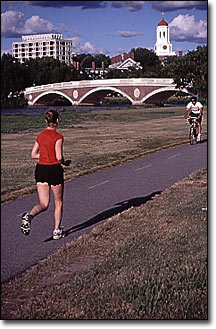 The Charles River seems a basic, indeed a natural foundation
of life at Harvard. It provides scenery for jogging, bike
rides or romantic evening walks, offers picturesque views
out the windows of several houses, establishes a cold barrier
to cross on the way to Harvard's athletic facilities, and
a home for Harvard's boathouses and crew teams. The Charles River seems a basic, indeed a natural foundation
of life at Harvard. It provides scenery for jogging, bike
rides or romantic evening walks, offers picturesque views
out the windows of several houses, establishes a cold barrier
to cross on the way to Harvard's athletic facilities, and
a home for Harvard's boathouses and crew teams.
Yet just as Harvard's buildings have seen many shapes and
sizes, and served many functions in the life of the University,
the river has had different roles in the history and pre-history
of New England. In the same way that Harvard Yard today would
be unrecognizable to those accustomed to it in the 17th century,
the very shape of the Charles River today would startle the
first Europeans who charted it, and the Native Americans who
used it before them. While it seems perhaps the most natural
of places in Cambridge, this landscape itself was a
human invention of the nineteenth century. Through its history,
the Charles has been constantly re-invented, each time serving
a different role in the history of Boston, Cambridge and the
dozens of other towns it flows through.
The sources on this site show some of the ways the Charles
has changed in the last four centuries.
Begin by exploring Native American
life along the Charles, and the way these first residents
of the region shaped the river to support themeselves.
Then look at the very different role the Charles River took
during the American Revolution.
Just as the Charles dominated the beginning of the American
Revolution, so too did it usher in America's next revolution,
the industrial revolution. Consider the changing economic
role of the Charles.
Bostonians, Cantabridgians, New Englanders and
Americans have often tried to control the Charles to suit their changing needs. By mapping
it, bridging it, and physically moving it, they have, over generations, re-invented it.
Once you have browsed the site, you can complete these assignments
for section or your final paper about the Charles river.
|